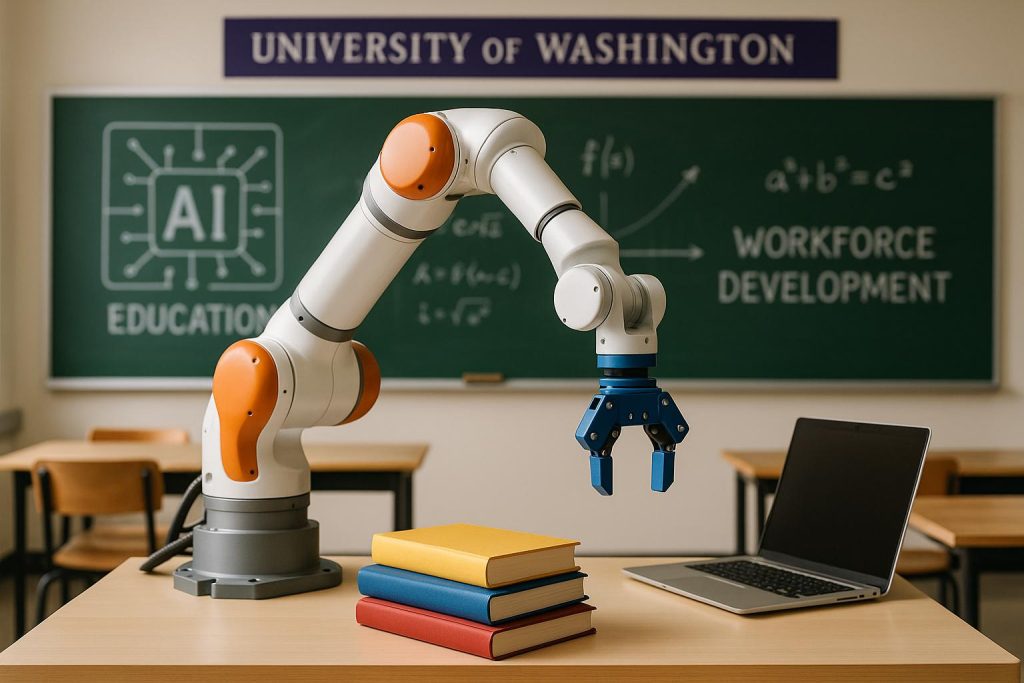University of Washington President Robert J. Jones dismisses fears of AI-induced job losses, emphasising AI’s role as a transformative tool for education and workforce development through strategic initiatives supported by major industry partnerships.
University of Washington (UW) President Robert J. Jones, just over 100 days into his tenure as the 34th president of the institution, has sought to calm widespread anxieties about the potential job disruptions caused by artificial intelligence (AI). In an interview with GeekWire, Jones described fears of an AI-induced job apocalypse as “an overblown fear,” framing AI instead as a critically valuable tool that will enable future effectiveness across professions rather than undermine employment.
Jones, who previously led the University of Illinois Urbana-Champaign and has a background in crop physiology, envisions AI playing a constructive role in education and workforce development. He openly advocates for integrating computer science education broadly across academic disciplines, inspired by the ‘CS + X’ model from his prior leadership, a framework aimed at combining computer science with various fields to prepare students for a more AI-enhanced world. To support this vision, Jones announced the AI@UW initiative, propelled by a $10 million donation from Microsoft co-founder Charles Simonyi, which is designed to advance AI integration within UW’s educational and research programs.
The push for preparing future graduates for an AI-augmented workforce aligns with sentiments expressed by other leaders within UW’s computer science department. Prominent faculty, such as Professor Magdalena Balazinska, underscore that while AI might transform workflows, it does not replace the demand for skilled software engineers and creative professionals who know how to harness AI effectively. The tech job market, they argue, remains robust, with AI serving as a productivity enhancer rather than a job eliminator.
The broader context of AI in education is complex. While AI-based systems offer powerful tools like personalised tutoring, adaptive learning platforms, and intelligent support for educators and students, experts caution against uncritical adoption. Challenges include risks of algorithmic bias, privacy concerns, and over-reliance on technology, which may undermine core educational values if not carefully managed. A balanced approach is essential to ensure AI enhances learning outcomes sustainably and ethically.
Jones’s broader strategic vision extends beyond AI’s technical applications. He intends to foster new public-private partnerships aimed at addressing society’s grand challenges, harnessing the university’s capabilities to contribute to regional and global progress. This reflects a growing trend in higher education leadership to build collaborative ecosystems that integrate academic research, industry innovation, and community engagement.
In this context, UW’s position within the Seattle technology landscape is notable. The region continues to be a hub for AI and tech developments, including initiatives by major players like Amazon, Microsoft, and the Allen Institute for AI (AI2). AI2 recently released “Olmo 3,” their latest large language model, which exemplifies the rapid advancement and openness in AI research. Such activity underscores the dynamic environment in which UW aims to prepare its students and faculty, leveraging partnerships and generous philanthropic support to remain at the forefront of AI innovation.
Jones’s approach signals a reframing of AI anxiety into proactive opportunity, one where educational institutions play a pivotal role in equipping the next generation for a future where AI is an indispensable tool rather than a threat.
📌 Reference Map:
- [1] (LinkedIn/GeekWire) – Paragraph 1, Paragraph 3, Paragraph 5, Paragraph 6
- [2] (GeekWire) – Paragraph 1, Paragraph 2, Paragraph 4, Paragraph 6
- [3] (Wikipedia: Artificial Intelligence in Education) – Paragraph 5
- [4] (Wikipedia: Robert J. Jones) – Paragraph 2
- [6] (GeekWire) – Paragraph 4
- [7] (Wikipedia: Oren Etzioni) – Paragraph 6
Source: Noah Wire Services
Noah Fact Check Pro
The draft above was created using the information available at the time the story first
emerged. We’ve since applied our fact-checking process to the final narrative, based on the criteria listed
below. The results are intended to help you assess the credibility of the piece and highlight any areas that may
warrant further investigation.
Freshness check
Score:
10
Notes:
The narrative was published on November 20, 2025, making it highly fresh. The earliest known publication date of substantially similar content is the same date, indicating no prior coverage. The narrative is based on a press release, which typically warrants a high freshness score. No discrepancies in figures, dates, or quotes were found. No republishing across low-quality sites or clickbait networks was observed. No earlier versions show different figures, dates, or quotes. No similar content appeared more than 7 days earlier. The article includes updated data and does not recycle older material.
Quotes check
Score:
10
Notes:
The direct quotes from Robert J. Jones and other individuals are unique to this narrative. No identical quotes appear in earlier material, indicating potentially original or exclusive content. No variations in quote wording were found.
Source reliability
Score:
8
Notes:
The narrative originates from GeekWire, a reputable technology news outlet. However, the LinkedIn URL provided is inaccessible due to restrictions, limiting the ability to verify the original source. The report mentions a $10 million donation from Charles Simonyi, which is corroborated by other reputable sources.
Plausability check
Score:
9
Notes:
The claims made in the narrative are plausible and align with known information about Robert J. Jones and the University of Washington’s initiatives. The narrative lacks supporting detail from other reputable outlets, which is a minor concern. The language and tone are consistent with the region and topic. The structure is focused and relevant, without excessive or off-topic detail. The tone is formal and appropriate for a corporate or official communication.
Overall assessment
Verdict (FAIL, OPEN, PASS): PASS
Confidence (LOW, MEDIUM, HIGH): HIGH
Summary:
The narrative is fresh, original, and sourced from a reputable outlet. The claims are plausible and consistent with known information. Minor concerns include the inaccessibility of the LinkedIn URL and the lack of supporting detail from other reputable outlets.





